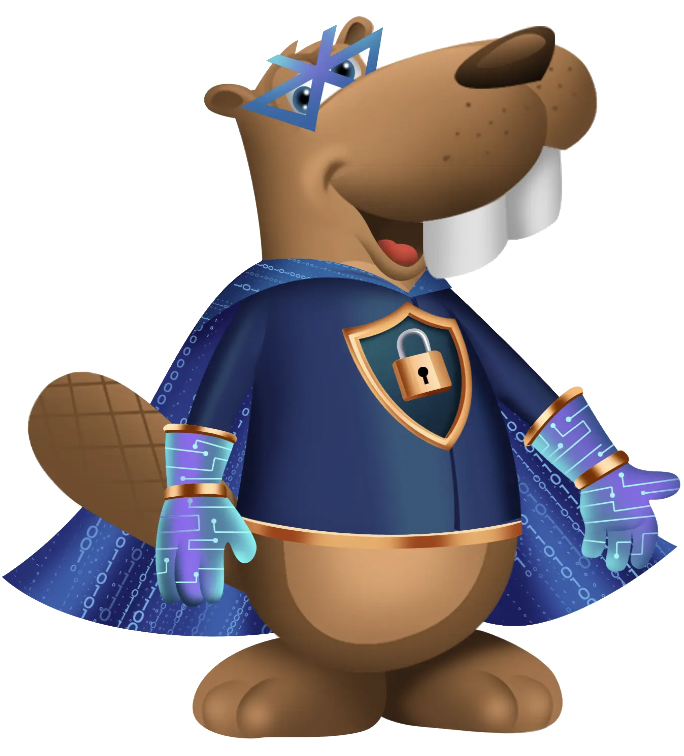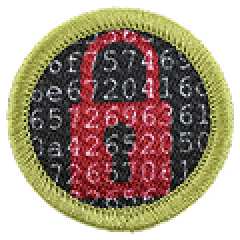Cybersecurity


There is no official Cybersecurity merit badge pamphlet.
Resources
- Cybersecurity Merit Badge Workbook
- Scoutmaster Bucky's Merit Badge Advancement Quick Reference
- Scoutmaster Bucky's Acknowledgement Form
Cybersecurity Requirements
Current Scouts BSA requirements
as of December 6, 2025
as of December 6, 2025
1.
Safety. Do the following:
a.
View the Personal Safety Awareness "Digital Safety" video (with your
parent or guardian's permission).
b.
Explain to your counselor how to protect your digital footprint,
such as while using social media, mobile device apps, and online gaming.
Show how to set privacy settings to protect your personal information,
including photos of yourself or your location.
c.
Discuss first aid and prevention for potential injuries, such as eye
strain, repetitive injuries, and handling electronics devices, that
could occur during repeated use. Discuss how to keep yourself physically
safe while using a mobile device (for example while walking or
biking).
2.
Ethics. Do the following:
a.
Relate three points of the Scout law to things people do on the
internet or with computers, phones, and other connected electronic
devices.
b.
Discuss with your counselor examples of ethical and unethical
behavior in cyberspace. Include how to act responsibly when you
encounter situations such as: coming across an unattended or unlocked
computer or mobile device; observing someone type their password or
seeing it written down near a computer; or discovering a website that is
not properly secured. Explain why these situations require good
judgement, and how the Scout Law and personal values should guide your
actions.
3.
Fundamentals. Do the following and discuss each with your
counselor:
a.
Describe three types of computer systems that need protecting and
explain why.
b.
Explain the "C.I.A. Triad"—Confidentiality, Integrity, and
Availability—and why these three principles are fundamental to
cybersecurity.
4.
Cyber Threats, Vulnerabilities, and Attacks. Do the following and
discuss each with your counselor:
a.
Define the terms vulnerability, threat, and exploit, and give an
example of each that might apply to a website or software product you
use.
b.
Pick one type of malware (such as virus, worm, Trojan, backdoor,
spyware, or ransomware) and find out how it works. Explain what it does
and the harm it can cause.
c.
Identify two risks of using public Wi-Fi and describe how to reduce
or avoid those risks.
d.
Describe what spoofing and phishing are, and how to recognize a
message or website that might be trying to trick you. Explain what steps
you should take to protect yourself and others if you come across one.
e.
Current Events. Do ONE of the following:
1.
Read an article or a news report about a recent cybersecurity
incident, such as a data breach or malware infection. Explain how the
incident happened (to the best of your ability based on the information
available) and what the consequences are or might be to the victim.
2.
With your parent or guardian's permission, watch a movie or read a
book in which cybersecurity plays a significant role. Discuss how
cybersecurity topics were depicted and how realistic you think it was.
f.
Create a list of what is part of your cyber attack surface including
all the ways someone could try to access your personal information or
devices—such as online accounts, apps, or home networks.
5.
Cyber Defenses. Do the following:
a.
Describe three technologies that are used to defend a computer or
network, such as access controls, antivirus software, firewall,
intrusion detection/prevention systems, and Virtual Private Network.
b.
Installing updates. Do the following:
1.
Explain to your counselor the importance of installing the latest
updates on your computer, why they are needed, and what kinds of
problems they can prevent.
2.
Demonstrate to your counselor how to check for, download, and
install the latest updates for your computer or mobile device, or
another computer you have permission to use (if you are unable to do
this on your computer, you may use an online guide with screenshots to
demonstrate this). Show your counselor how to verify that your computer
or mobile device is up-to-date.
c.
System security. With your parent or guardian's permission,
do THREE of the following using a computer or mobile device, and discuss
with your counselor:
1.
Describe what makes a good password and why. Set or change an
account password to one that is "strong."
2.
Describe multi-factor authentication (MFA) and how it can be used to
improve security. Demonstrate how to use an authenticator app or other
MFA function.
3.
Install and set up a password manager. Demonstrate how it works to
your counselor.
4.
Run a virus scan. Show the results to your counselor.
5.
Using a command line or other built-in tool, see what programs or
processes are running on your computer. Discuss with your counselor what
you see and what surprises you.
6.
Use a command line interface to view your computer's open network
connections. Discuss the results with your counselor.
7.
Demonstrate how to back up your data from a mobile device to a local
computer or the cloud.
8.
Research best practices for protecting a home computer or network,
and make a checklist of FIVE things you and your family can do to stay
secure.
9.
Identify one or more other vulnerabilities on your home computer or
network or another computer or network you have permission to use and
discuss with your counselor. With permission from the system owner, take
the necessary actions to fix it.
6.
Cryptography. Do the following:
a.
Research and explain to your counselor three situations where
encryption is used in cybersecurity. For each situation, describe what
kind of encryption is used and why it is important.
b.
Show how you can know if your connection to a website is
encrypted.
c.
Do ONE of the following:
1.
Create your own encryption code, such as a substitution cipher or
code book, and demonstrate using it to encrypt and decrypt a message.
Describe the strengths and weaknesses of your code.
2.
Download and set up an app (from an official app store) that uses
end-to-end encryption. Explain to your counselor what this means, how it
works, and why it is more secure than other forms of communication (e.g.
SMS).
3.
Use a hashing tool (for example, using SHA or MD5) to create a
checksum for a file, document, or piece of text. Have a fellow Scout or
your counselor make a change to it, then recreate the checksum and
compare the new checksum to the original as a demonstration of file
integrity checking.
4.
Create your own PGP (pretty good privacy) email key. Share your
public key with others (and your counselor). Also, get their public keys
and add them to your computer's key ring. Send a message that has been
digitally encrypted.
7.
Connected Devices and Internet of Things (IoT). Describe to your
counselor four electronic devices you encounter that could be connected to
the internet, why this connectivity can be useful, what risks are posed by
the connectivity, and how they could be protected.
8.
Cybersecurity Activities. Do ONE of the following:
a.
Learn about a cybersecurity competition, camp, or other activity you
could participate in (either now or in the future). Share what you
learned with your counselor, including the type of activity, time
commitment, and age of participants.
b.
Participate in a cybersecurity competition with members of your
troop, school, or some other group approved by your counselor. Either
design your own competition or use an existing platform.
c.
Give a presentation to your patrol, troop, or another group approved
by your counselor, on a cybersecurity topic of your choice. Your
presentation must include at least one demonstration and/or hands-on
activity.
9.
Careers. Do ONE of the following:
a.
Identify three career opportunities that would use skills and
knowledge in cybersecurity. Pick one and research the training,
education, certification requirements, experience, and expenses
associated with entering the field. Research the prospects for
employment, starting salary, advancement opportunities and career goals
associated with this career. Discuss what you learned with your
counselor and whether you might be interested in this career.
b.
Visit a business or organization that does work in cybersecurity.
Find out about different work roles, what they do, and how they acquired
their knowledge through college degrees or certifications. Share what
you learned with your counselor.